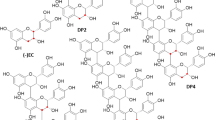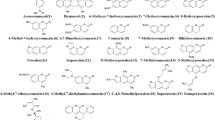Abstract
Recently authorities and the media have published reports of increased coumarin levels in Christmas biscuits, gingerbread, cinnamon cookies and other foods. The maximum tolerance limits for coumarin in food are set out in EC Directive 88/388/ECC. Since the standard use of analytical techniques, such as HPLC–UV, are only limitedly suitable for verifying compliance with the regulatory limit of 2 mg/kg for coumarin in food, a selective, sensitive isotope dilution LC–MS/MS method for determining coumarin content in foods was developed, tested and validated, and the results then compared to the HPLC–UV method. This LC–MS/MS method increased selectivity and raised sensitivity by a factor of 100 compared to the HPLC–UV technique. The respective limits of determination and quantification for the method were 0.03 and 0.05 mg/kg, respectively, with an RSD of 1–8% and a linearity range of 0.1–500 ng/mL (corresponding to 0.05–250 mg/kg in food). In addition, a selection of around 500 food samples was also tested for coumarin content using the LC−MS/MS technique.





Similar content being viewed by others
References
Fenaroli’s handbook of flavors ingredients (1971) The Chemical Rubber Co., S. 400
EFSA (2004) Opinion of the scientific panel on food additives, flavourings, processing aids and materials in contact with food (AFC) on a request from the commission related to coumarin, adopted on 6 October 2004. EFSA J 104:1–36
BfR (2006) Verbraucher, die viel Zimt verzehren, sind derzeit zu hoch mit Cumarin belastet. Gesundheitliche Bewertung des BfR Nr. 043/2006 vom 16 Juni 2006 http://www.bfr.bund.de/cm/208/verbraucher_die_viel_zimt_verzehren_sind_derzeit_zu_hoch_mit_cumarin_belastet.pdf
BfR (2006) Hohe tägliche Aufnahmemengen von Zimt: Gesundheitsrisiko kann nicht ausgeschlossen werden. Gesundheitliche Bewertung Nr. 044/2006 des BfR vom 18. August 2006 http://www.bfr.bund.de/cm/208/hohe_taegliche_aufnahmemengen_von_zimt_gesundheitsrisiko_kann_nicht_ausgeschlossen_werden.pdf
Council Directive of 22 June 1988 on the approximation of the laws of the Member States relating to flavourings for use in foodstuffs and to source materials for their production (88/388 EEC). Off J Europ Comm L184, 61–66
Neufassung der Aromenverordnung vom 02. Mai 2006 im BGBl. I Nr. 23 S. 1127 ff. vom 15.05.2006
Sostaric T, Boyce MC, Spickett EE (2000) Analysis of the volatile components in vanilla extracts and flavorings by solid-phase microextraction and gas chromatography. J Agric Food Chem 48:5802–5807
Martin GE, Guinand GG, Figert DM (1973) Comparison of gas–liquid, gas–solid, liquid–liquid, and liquid–solid chromatographic techniques in analysis of vanillin and ethyl vanillin in alcoholic solutions. J Agric Food Chem 21:544–547
de Jager LS, Perfetti GA, Diachenko GW (2007) Determination of coumarin, vanillin, and ethyl vanillin in vanilla extract products: liquid chromatography mass spectrometry method and validation studies. J Chromatogr A 1145:83–88
Kohn A, Gratzfeld-Hüsgen A (1997) Bestimmung von Aromastoffen in Lebensmitteln mit HPLC und Diodenarray-Detektion. GIT Labor-Fachzeitschrift 9/97:888–889
Lander V, Wörner M, Kirchenmayer Ch, Wintoch H, Schreier P (1990) Anwendung der Festphasenextraktion zur raschen Probenvorbereitung bei der Bestimmung von Lebensmittelinhaltsstoffen II. Asaron, Chinin, Cumarin und Quassin in Trinkbranntwein. Z Lebensm Unters Forsch 190:410–413
Ehlers D, Hilmer S, Bartholomae S (1995) Hochdruckflüssigchromatographische Untersuchung von Zimt-CO2-Hochdruckextrakten im Vergleich mit Zimtölen. Z Lebensm Unters Forsch 200:282–288
He ZD, Qiao CF, Han QB, Cheng CL, Xu HX, Jiang RW, But PPH, Shaw PC (2005) Authentication and quantitative analysis on the chemical profile of cassia bark (cortex cinnamoni) by high pressure liquid chromatography. J Agric Food Chem 53:2424–2428
Ehlers D, Pfister M, Brok WR, Toffel-Nadolny P (1995) HPLC Analysis of Tonka Bean Extracts. Z Lebensm Unters Forsch 201:278–282
Ehlers D, Platte S, Brok WR, Gerard, Quirin KW (1997) HPLC analysis of sweet clover extracts. Deut Lebensm Rundsch 93:77–79
Grundschober F (1974) Coumarin—determination in alcoholic beverages by high performance liquid chromatography. Z Lebensm Unters Forsch 204:399
Author information
Authors and Affiliations
Corresponding author
Rights and permissions
About this article
Cite this article
Raters, M., Matissek, R. Analysis of coumarin in various foods using liquid chromatography with tandem mass spectrometric detection. Eur Food Res Technol 227, 637–642 (2008). https://doi.org/10.1007/s00217-007-0767-9
Received:
Revised:
Accepted:
Published:
Issue Date:
DOI: https://doi.org/10.1007/s00217-007-0767-9




